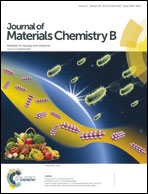Electrospun PCL/PEO coaxial fibers for basic fibroblast growth factor delivery
Abstract
The poor innate healing capacity of fibroblastic tissues, such as pelvic floor fascia, is attributed to the scarcity of fibroblasts to produce collagen, as the main collagen producing cells. Coaxial electrospun PCL/PEO fibers containing basic fibroblast growth factor (FGF-2) were evaluated for the local and temporal delivery of FGF-2 for promoting fibroblast proliferation. PCL/PEO coaxial fibers with a highly porous surface were successfully developed using coaxial electrospinning. The diameter of the PCL/PEO microfibers produced by coaxial electrospinning could be tuned by the electrospinning parameters. XPS surface chemistry probing and CA wettability analysis confirmed that the outer surface of the coaxial fibers is PCL. The protein was successfully encapsulated and a sustained release was observed over more than 9 days. In vitro, PCL/PEO coaxial fibers supported fibroblast cell adhesion. In addition, PCL/PEO coaxial fibers containing FGF-2 significantly enhanced fibroblast cell viability and proliferation. Further, Coll-I expression was significantly expressed after day 1 while down-regulated after day 9 compared to the control group. These results indicate that coaxial polymeric fibers allow local and sustained growth factor delivery with prolonged efficacy and longevity for connective tissue regeneration.


 Please wait while we load your content...
Please wait while we load your content...